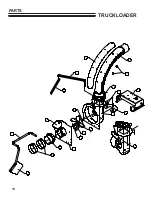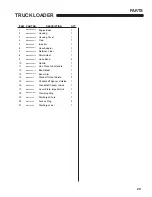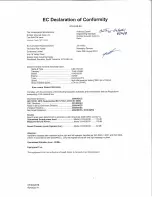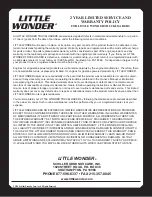
1
5
TRUCKLOADER
OPERATING
This machine has been designed for two methods of
vacuuming debris:
-
With the handle of the Intake Nozzle in the
operator’s hands, move the nozzle back and forth
in a sweeping motion over the debris
-
Rotate Intake Nozzle to lay sideways on the
ground. By placing the Nozzle in this position,
debris can be raked into the nozzle by an
operator.
While large amounts of debris can be vacuumed
quickly with this machine, caution must be taken to
avoid blocking the airflow into the Nozzle.
STOPPING THE ENGINE
When operation is complete or the unit needs to be
checked or a clog needs to be cleared:
1. Move the throttle to SLOW.
2. Set the engine and fuel lever to the OFF position.
3. Note: Impeller will continue to rotate for several
seconds after engine is stopped.
EXCESSIVE VIBRATION
Shut off the engine immediately if abnormal/excessive
vibration occurs. Remove spark plug wire. Find
the cause of vibration and repair it. Some possible
causes for excessive vibration are:
-
Damaged impeller
-
Loose impeller bolt
-
Loose impeller key
-
Lodged objects
CLOGS
To prevent clogs, do not overfeed, especially with
heavy wet material.
Pay attention to how full the debris receptacle is.
Overfilled debris receptacles cause material to back
up and get tightly packed in the discharge cute.
REMOVING CLOGS
If a decrease in suction is experienced, there may be
a debris blockage in the hose. Often a clogged hose
can be cleared by stretching the hose out straight with
the engine running. If the hose does not clear, you
will need to remove the hose. Before removing the
hose or attempting to clear a clog manually:
-
STOP the engine. Put the engine switch in the
OFF position.
-
Wait for the impeller to come to a complete stop.
-
Disconnect the spark plug wires so impeller
movement cannot accidentally start the engine.
Removing Clogs ( continued)
CAUTION SHOULD BE USED WHEN CLEARING
DEBRIS FROM INSIDE THE HOUSING. GLOVES
SHOULD BE WORN AS SHARP EDGES ON THE
IMPELLER OR IN THE DEBRIS MAY BE PRESENT.
Remove the Hose Assembly from the Inlet Flange
Assembly. With this removed, open the Inlet Flapper
and remove any debris that is clogging the housing.
Remove the Discharge Chute from the Transition
Discharge tube’s flange. With the Chute removed,
inspect the Transition Discharge part of the housing
and remove any debris clogging this area.
Reassemble removed parts, reconnect the spark plug
wire and resume operation.
NEVER TRANSPORT MACHINE
WHILE IT IS RUNNING
TRANSPORT
1. Shut off the engine and fuel valve.
2. Disconnect the hose from the power unit.
3. Remove the boom assembly from the frame (it
can stay with the hose.)
4. Remove the discharge chute.
5. Transport the hose/boom assembly and discharge
chute secured in the truck or trailer.
6. Do not exceed 30 mph. High speeds together with
rough roads can cause damage to the unit
OPERATION























